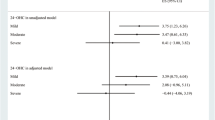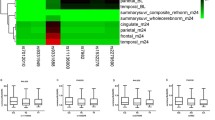Abstract
Recent studies have suggested that variants of CYP46A1, encoding cholesterol 24-hydroxylase (CYP46), confer risk for Alzheimer’s disease (AD), a prospect substantiated by evidence of genetic association from several quantitative traits related to AD pathology, including cerebrospinal fluid (CSF) levels of the 42 amino-acid cleavage product of β-amyloid (Aβ42) and the tau protein. In the present study, these claims have been explored by the genotyping of previously associated markers in CYP46A1 in three independent northern European case-control series encompassing 1323 individuals and including approximately 400 patients with measurements of CSF Aβ42 and phospho-tau protein levels. Tests of association in case-control models revealed limited evidence that CYP46A1 variants contributed to AD risk across these samples. However, models testing for potential effects upon CSF measures suggested a possible interaction of an intronic marker (rs754203) with age and APOE genotype. In stratified analyses, significant effects were evident that were restricted to elderly APOE ε4 carriers for both CSF Aβ42 (P=0.0009) and phospho-tau (P=0.046). Computational analyses indicate that the rs754203 marker probably does not impact the binding of regulatory factors, suggesting that other polymorphic sites underlie the observed associations. Our results provide an important independent replication of previous findings, supporting the existence of CYP46A1 sequence variants that contribute to variability in β-amyloid metabolism.
Similar content being viewed by others
References
Alafuzoff I, Iqbal K, Fridén H, Adolfsson R, Winblad B (1987) Histopathological criteria for progressive dementia disorders: clinical-pathological correlation and classification by multivariate data analysis. Acta Neuropathol 74:209–225
Andreasen N, Blennow K (2002) Beta-amyloid (Abeta) protein in cerebrospinal fluid as a biomarker for Alzheimer’s disease. Peptides 23:1205–1214
Andreasen N, Hesse C, Davidsson P, Wallin A, Minthon L, Winblad B, Vanderstichele H, Vanmechelen E, Blennow K (1999) Cerebrospinal fluid β-amyloid(1–42) in Alzheimer’s disease: differences between early- and late-onset Alzheimer disease and stability during the course of disease. Arch Neurol 56:673–680
Andreasen N, Minthon L, Davidsson P, Vanmechelen E, Vanderstichele H, Winblad B, Blennow K (2001) Evaluation of CSF-tau and CSF-Abeta42 as diagnostic markers for Alzheimer disease in clinical practice. Arch Neurol 58:373–379
Bjorkhem I, Lutjohann D, Breuer O, Sakinis A, Wennmalm A (1997) Importance of a novel oxidative mechanism for elimination of brain cholesterol. Turnover of cholesterol and 24(S)-hydroxycholesterol in rat brain as measured with 18O2 techniques in vivo and in vitro. J Biol Chem 272:30178–30184
Borroni B, Archetti S, Agosti C, Akkawi N, Brambilla C, Caimi L, Caltagirone C, Di Luca M, Padovan A (2003) Intronic CYP46 polymorphism along with ApoE genotype in sporadic Alzheimer disease: from risk factors to disease modulators. Neurobiol Aging (in press)
Desai P, DeKosky ST, Kamboh MI (2002) Genetic variation in the cholesterol 24-hydroxylase (CYP46) gene and the risk of Alzheimer’s disease. Neurosci Lett 328:9–12
Ehehalt R, Keller P, Haass C, Thiele C, Simons K (2003) Amyloidogenic processing of the Alzheimer beta-amyloid precursor protein depends on lipid rafts. J Cell Biol 160:113–123
Folstein MF, Folstein SE, McHugh PR. (1975) “Mini-mental state”. A practical method for grading the cognitive state of patients for the clinician. J Psychiatr Res 12:189–198
Grundke-Iqbal I, Iqbal K, Tung YC, Quinlan M, Wisniewski HM, Binder LI (1986) Abnormal phosphorylation of the microtubule-associated protein tau (tau) in Alzheimer cytoskeletal pathology. Proc Natl Acad Sci USA 83:4913–4917
Hartmann T (2001) Cholesterol A beta and Alzheimer’s disease. Trends Neurosci 24:S45–48
Hill WG (1974) Estimation of linkage disequilibrium in randomly mating populations. Heredity 33:229–239
Kang J, Lemaire HG, Unterbeck A, Salbaum JM, Masters CL, Grzeschik KH, Multhaup G, Beyreuther K, Muller-Hill B (1987) The precursor of Alzheimer’s disease amyloid A4 protein resembles a cell-surface receptor. Nature 325:733–773
Karolchik D, Baertsch R, Diekhans M, Furey TS, Hinrichs A, Lu YT, Roskin KM, Schwartz M, Sugnet CW, Thomas DJ, Weber RJ, Haussler D, Kent WJ (2003) The UCSC Genome Browser Database. Nucleic Acids Res 31:51–4
Kölsch H, Lutjohann D, Ludwig M, Schulte A, Ptok U, Jessen F, Bergmann K von, Rao ML, Maier W, Heun R (2002) Polymorphism in the cholesterol 24S-hydroxylase gene is associated with Alzheimer’s disease. Mol Psychiatry 7:899–902
Lenhard B, Sandelin A, Mendoza L, Engström P, Jareborg N, Wasserman WW (2003) Identification of conserved regulatory regions by comparative genome analysis. J Biol 2:13
Lund EG, Guileyardo JM, Russell DW (1999) cDNA cloning of cholesterol 24-hydroxylase, a mediator of cholesterol homeostasis in the brain. Proc Natl Acad Sci USA 96:7238–7243
Masters CL, Simms G, Weinman NA, Multhaup G, McDonald BL, Beyreuther K (1985) Amyloid plaque core protein in Alzheimer disease and Down syndrome. Proc Natl Acad Sci USA 82:4245–4249
McKhann G, Drachman D, Folstein M, Katzman R, Price D, Stadlan EM (1984) Clinical diagnosis of Alzheimer’s disease: report of the NINCDS-ADRDA Work Group under the auspices of Department of Health and Human Services Task Force on Alzheimer’s Disease. Neurology 34:939–944
Mirra SS, Heyman A, McKeel D, Sumi SM, Crain BJ, Brownlee LM, Vogel FS, Hughes JP, Belle G van, Berg L (1991) The Consortium to Establish a Registry for Alzheimer’s Disease (CERAD). Part II. Standardization of the neuropathologic assessment of Alzheimer’s disease. Neurology 41:479–486
Papassotiropoulos A, Streffer JR, Tsolaki M, Schmid S, Thal D, Nicosia F, Iakovidou V, Maddalena A, Lutjohann D, Ghebremedhin E, Hegi T, Pasch T, Traxler M, Bruhl A, Benussi L, Binetti G, Braak H, Nitsch RM, Hock C (2003) Increased brain beta-amyloid load, phosphorylated tau, and risk of Alzheimer disease associated with an intronic CYP46 polymorphism. Arch Neurol 60:29–35
Povey S, Lovering R, Bruford E, Wright M, Lush M, Wain H (2001) The HUGO Gene Nomenclature Committee (HGNC). Hum Genet 109:678–680
Prince JA, Feuk L, Howell WM, Jobs M, Emahazion T, Blennow K, Brookes AJ (2001) Robust and accurate single nucleotide polymorphism genotyping by dynamic allele-specific hybridization (DASH): design criteria and assay validation. Genome Res 11:152–162
Prince JA, Feuk L, Gu HF, Johansson B, Gatz M, Blennow K, Brookes AJ (2003) Genetic variation in a haplotype block spanning IDE influences Alzheimer disease. Hum Mutat 22:363–371
Prince JA, Zetterberg H, Andreasen N, Marcusson J, Blennow K (2004) The APOE ε4 allele is associated with reduced cerebrospinal fluid levels of Aβ42. Neurology (in press)
Puglielli L, Tanzi RE, Kovacs DM (2003) Alzheimer’s disease: the cholesterol connection. Nat Neurosci 6:345–351
Sandelin A, Alkema W, Engström P, Wasserman WW, Lenhard B (2004) JASPAR: an open-access database for eukaryotic transcription factor binding profiles. Nucleic Acids Res 32 (in press)
Selkoe DJ (2001) Alzheimer’s disease: genes, proteins, and therapy. Physiol Rev 81:741–766
Simons M, Keller P, Dichgans J, Schulz JB (2001) Cholesterol and Alzheimer’s disease: is there a link? Neurology 25:57:1089–1093
Simons M, Schwarzler F, Lutjohann D, Bergmann K von, Beyreuther K, Dichgans J, Wormstall H, Hartmann T, Schulz JB (2002) Treatment with simvastatin in normocholesterolemic patients with Alzheimer’s disease: a 26-week randomized, placebo-controlled, double-blind trial. Ann Neurol 52:346–350
Sjögren M, Davidsson P, Tullberg M, Minthon L, Wallin A, Wikkelso C, Granerus AK, Vanderstichele H, Vanmechelen E, Blennow K (2001) Both total and phosphorylated tau are increased in Alzheimer’s disease. J Neurol Neurosurg Psychiatry 70:624–630
Stormo GD (2000) DNA binding sites: representation and discovery. Bioinformatics 16:16–23
Vanderstichele H, Van Kerschaver E, Hesse C, Davidsson P, Buyse MA, Andreasen N, Minthon L, Wallin A, Blennow K, Vanmechelen E (2000) Standardization of measurement of beta-amyloid(1–42) in cerebrospinal fluid and plasma. Amyloid 7:245–258
Vanmechelen E, Vanderstichele H, Davidsson P, Van Kerschaver E, Van Der Perre B, Sjögren M, Andreasen N, Blennow K (2000) Quantification of tau phosphorylated at threonine 181 in human cerebrospinal fluid: a sandwich ELISA with a synthetic phosphopeptide for standardization. Neurosci Lett 285:49–52
Wolozin B, Kellman W, Ruosseau P, Celesia GG, Siegel G (2000) Decreased prevalence of Alzheimer disease associated with 3-hydroxy-3-methyglutaryl coenzyme A reductase inhibitors. Arch Neurol 57:1439–1443
Xia W (2001) Amyloid metabolism and secretases in Alzheimer’s disease. Curr Neurol Neurosci Rep 1:422–427
Yusuf S, Peto R, Lewis J, Collins R, Sleight P (1985) Beta blockade during and after myocardial infarction: an overview of the randomized trials. Prog Cardiovasc Dis 27:335–371
Acknowledgements
Generous financial support was provided by Pfizer, the Loo and Hans Ostermans Foundation, the Knut and Alice Wallenberg Foundation, the National Institute on Aging (AG:08861), the Swedish Old Servants Foundation (Gamla Tjänarinnor), the Åke Wibergs Foundation, the Torsten and Ragnar Sàderbergs Foundation, the Fredrik and Ingrid Thurings Foundation, the Petrus and Augusta Hedlunds Foundation, and the Swedish Alzheimer Foundation (Alzheimerfonden).
Author information
Authors and Affiliations
Corresponding author
Rights and permissions
About this article
Cite this article
Johansson, A., Katzov, H., Zetterberg, H. et al. Variants of CYP46A1 may interact with age and APOE to influence CSF Aβ42 levels in Alzheimer’s disease. Hum Genet 114, 581–587 (2004). https://doi.org/10.1007/s00439-004-1107-9
Received:
Accepted:
Published:
Issue Date:
DOI: https://doi.org/10.1007/s00439-004-1107-9




